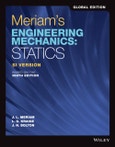Known for its accuracy, clarity, and dependability, Meriam, Kraige, and Bolton's Engineering Mechanics: Statics, 9th Edition has provided a solid foundation of mechanics principles for more than 60 years. This text continues to help students develop their problem-solving skills with an extensive variety of engaging problems related to engineering design. In addition to new homework problems, the text includes a number of helpful sample problems. To help students build necessary visualization and problem-solving skills, the text strongly emphasizes drawing free-body diagrams, one of the most important skills needed to solve mechanics problems.
Table of Contents
1 Introduction to Statics 1
1/1 Mechanics 1
1/2 Basic Concepts 2
1/3 Scalars and Vectors 2
1/4 Newton’s Laws 5
1/5 Units 6
1/6 Law of Gravitation 9
1/7 Accuracy, Limits, and Approximations 10
1/8 Problem Solving in Statics 11
1/9 Chapter Review 14
2 Force Systems 17
2/1 Introduction 17
2/2 Force 17
Section A Two-Dimensional Force Systems 20
2/3 Rectangular Components 20
2/4 Moment 26
2/5 Couple 31
2/6 Resultants 34
Section B Three-Dimensional Force Systems 37
2/7 Rectangular Components 37
2/8 Moment and Couple 41
2/9 Resultants 48
2/10 Chapter Review 54
3 Equilibrium 55
3/1 Introduction 55
Section A Equilibrium in Two Dimensions 56
3/2 System Isolation and the Free-Body Diagram 56
3/3 Equilibrium Conditions 66
Section B Equilibrium in Three Dimensions 74
3/4 Equilibrium Conditions 74
3/5 Chapter Review 82
4 Structures 83
4/1 Introduction 83
4/2 Plane Trusses 84
4/3 Method of Joints 86
4/4 Method of Sections 92
4/5 Space Trusses 96
4/6 Frames and Machines 99
4/7 Chapter Review 105
5 Distributed Forces 106
5/1 Introduction 106
Section A Centers of Mass and Centroids 108
5/2 Center of Mass 108
5/3 Centroids of Lines, Areas, and Volumes 110
5/4 Composite Bodies and Figures; Approximations 118
5/5 Theorems of Pappus 122
Section B Special Topics 125
5/6 Beams - External Effects 125
5/7 Beams - Internal Effects 128
5/8 Flexible Cables 135
5/9 Fluid Statics 143
5/10 Chapter Review 153
6 Friction 154
6/1 Introduction 154
Section A Frictional Phenomena 155
6/2 Types of Friction 155
6/3 Dry Friction 155
Section B Applications of Friction in Machines 164
6/4 Wedges 164
6/5 Screws 165
6/6 Journal Bearings 169
6/7 Thrust Bearings; Disk Friction 169
6/8 Flexible Belts 172
6/9 Rolling Resistance 173
6/10 Chapter Review 176
7 Virtual Work 177
7/1 Introduction 177
7/2 Work 177
7/3 Equilibrium 180
7/4 Potential Energy and Stability 188
7/5 Chapter Review 197
Appendix A Area Moments of Inertia 198
A/1 Introduction 198
A/2 Definitions 199
A/3 Composite Areas 206
A/4 ProducLts of Inertia and Rotation of Axes 209
Appendix B Mass Moments of Inertia 214
Appendix C Selected Topics of Mathematics 215
C/1 Introduction 215
C/2 Plane Geometry 215
C/3 Solid Geometry 216
C/4 Algebra 216
C/5 Analytic Geometry 217
C/6 Trigonometry 217
C/7 Vector Operations 218
C/8 Series 221
C/9 Derivatives 221
C/10 Integrals 222
C/11 Newton’s Method for Solving Intractable Equations 225
C/12 Selected Techniques for Numerical Integration 227
Appendix D Useful Tables 230
Table D/1 Physical Properties 230
Table D/2 Solar System Constants 231
Table D/3 Properties of Plane Figures 232
Table D/4 Properties of Homogeneous Solids 234
Table D/5 Conversion Factors; SI Units 238
Problems P-1
Index I-1
Problem Answers PA-1








